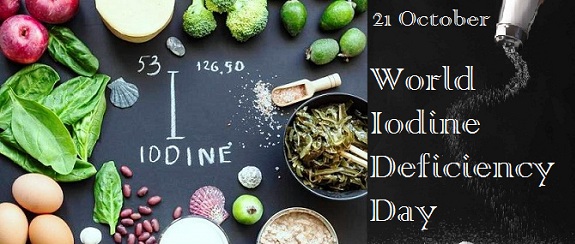- Six Reasons To Bring Millets To The Market!
- Hong Kong Court Makes Landmark Ruling Protecting Transgender Rights
- Substrate Promiscuity Of Fungi Generated Enzyme Laccase Shows Potential In Degrading Industrial Dye Effluents
- Union Minister Of Rural Development Holds A Meeting On ‘Cactus Plantation And Its Economic Usage’
- Ministry Of Tribal Affairs Organised One Day Mega Health Camp ‘Abua Bugin Hodmo-Our Better Health’ At Saraikela Kharsawan, Jharkhand
- Blue Flag Standards For Beaches In The Country
- India-Namibia Sign An MoU On Wildlife Conservation And Sustainable Biodiversity Utilization
- Hydrophobic Ingredients, In Combination With Obsolete Antibiotics, Can Counter Multidrug-Resistant Bacteria
- Promoting Cultivation Of Kala Namak Paddy
Reasons for iodine deficiency in India and ways to counter it
Posted by: 2021-10-21 19:14:20 ,By Admin

Every year, World Iodine Deficiency Day is observed on 21 October across the world. Iodine is an element present in salt and is needed to regulate the thyroid hormone in our body, which in turn is responsible for a person's overall growth. This day is observed in order to raise awareness regarding the importance of iodine in an individual's development.
The World Health Organization (WHO) has been working since the 1980s to underline the effects of iodine deficiency by building national salt iodization programs. UNICEF along with the International Council for Control of Iodine Deficiency Disorders (ICCIDC) has strategized several international programs and has been able to provide 66 percent of homes with iodized salt.
Iodine deficiency leads to problems in a person's metabolism and can also hamper the development of the brain. Irregular secretion of thyroid hormones can lead to a condition called goiter as well.
Around 200 million people in India reportedly face a potential risk of Iron Deficiency Disorder (IDD). In 1962, India launched the National Goiter Control Program (NGCP) which was implemented in many States and UTs to ensure that there is adequate consumption of iodized salt in all households and through this initiative, the Total Goiter Rate (TGR) in the country has reduced significantly.
Here are some reasons why Iodine deficiency is prevalent in India:
In several parts of India such as North Indian states, the soil is iodine deficient and this is a major cause of increasing IDD in our country.
The consumption of iodized salt in the nation was only 71 percent, till last year. Also, salt is one of the most important sources of iodine but 30 percent of salt intake in homes is lost in cooking and only 70 percent is absorbed.
An iodine-rich diet plays a crucial role in reducing deficiency.
Here are some ways to minimize iodine deficiency:
- Intake of iodized salt on a daily basis of around 10g per day
- Bread has an iodine content of around 100g and two slices of it a day is a good source
- Milk is essential in one's diet, not only for iodine but also for proteins, vitamins, and calcium
- Seafood and sea vegetables are rich in iodine. Seafood also contains omega-3 fatty acids. The American Thyroid Association states that Iodine is present in soil and in seawater
- Eggs are vital and a good way to increase iodine in children
- Fruits such as bananas, strawberries, and vegetables like sweet potato and spinach contain essential brain nutrient folate
Read more: Click Here
You may like similar news
.jpg)
ICMR suggests giving mashed dals to infants instead of 'dal kaa pani'; shares list of complementary foods
ICMR in its recent guidelines recommends foods with semi-solid consistency to infants instead of wat...
.jpg)
Mango peel benefits: 8 surprising ways you can eat it, enhance your beauty routine
Mango peel has a unique flavour and potential health advantages that can be explored. Here are creat...
.jpg)
Rise in cancer incidences among younger people in India, 60 per cent patients below 40 are men: Study
A new study indicates a rise of cancer incidences amongst younger people. It showed that 60 per cent...
.jpg)
How a blood test can find the cause of your acne
What if the solution to acne lies not in topical remedies, over-the-counter creams or prescription m...
.jpg)
Diabetes tips: 14 healthy ways to manage your blood sugar in extreme summer heat
Want to manage your diabetes effectively and enjoy all that summer has to offer? Here are 14 tips fo...









